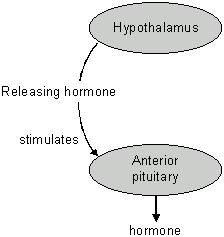 | ||
Pnas electrical synapses connect a network of gonadotropin releasing hormone neurons
Releasing hormones and inhibiting hormones are hormones whose main purpose is to control the release of other hormones, either by stimulating or inhibiting their release. They are also called liberins (/ˈlɪbərᵻnz/) and statins (/ˈstætᵻnz/) (respectively), or releasing factors and inhibiting factors. The principal examples are hypothalamic-pituitary hormones that can be classified from several viewpoints: they are hypothalamic hormones (originating in the hypothalamus), they are hypophysiotropic hormones (affecting the hypophysis, that is, the pituitary gland), and they are tropic hormones (having other endocrine glands as their target).
Contents
- Pnas electrical synapses connect a network of gonadotropin releasing hormone neurons
- Luteinizing hormone releasing hormone spanish meaning
- Mechanism
- Notable researchers
- References
For example, thyrotropin-releasing hormone (TRH) is released from the hypothalamus in response to low levels of secretion of thyroid-stimulating hormone (TSH) from the pituitary gland. The TSH in turn is under feedback control by the thyroid hormones T4 and T3. When the levels of TSH are too high, they feed back on the brain to shut down the secretion of TRH. Synthetic TRH is also used by physicians as a test of TSH reserve in the pituitary gland as it should stimulate the release of TSH and prolactin from this gland.
The main releasing hormones are as follows:
The main release-inhibiting hormones or inhibiting hormones are as follows:
There are various other inhibiting factors that also have tropic endocrine inhibition activity. Such activity is only one of many functions that they have (such as neurotransmitter and receptor antagonist roles), and they are not always called hormones, although many are neuropeptides or neurosteroids. They include the following:
Examples of releasing and inhibiting hormones for exocrine hormones are gastrin-releasing peptide (GRP) and gastric inhibitory polypeptide (GIP), which regulate gastrin production.
Luteinizing hormone releasing hormone spanish meaning
Mechanism
Releasing hormones increase (or, in case of inhibitory factors, decrease) the intracellular concentration of calcium (Ca2+), resulting in vesicle fusion of the respective primary hormone.
For GnRH, TRH and GHRH the increase in Ca2+ is achieved by the releasing hormone coupling and activating G protein coupled receptors coupled to the Gq alpha subunit, activating the IP3/DAG pathway to increase Ca2+. For GHRH, however, this is a minor pathway, the main one being the cAMP dependent pathway.
Notable researchers
Roger Guillemin and Andrew W. Schally were awarded the Nobel Prize in Physiology and Medicine in 1977 for their contributions to understanding "the peptide hormone production of the brain"; these scientists independently first isolated TRH and GnRH and then identified their structures.
